This study examined the level of agreement (Pearson product-moment correlation [
rP]), within- and between-day reliability (intraclass correlation coefficient [ICC]), and minimal detectable change of the Musclelab
TM Laser Speed (MLS) device on sprint time and force–velocity–power profiles in Division II
[...] Read more.
This study examined the level of agreement (Pearson product-moment correlation [
rP]), within- and between-day reliability (intraclass correlation coefficient [ICC]), and minimal detectable change of the Musclelab
TM Laser Speed (MLS) device on sprint time and force–velocity–power profiles in Division II Collegiate athletes. Twenty-two athletes (soccer = 17, basketball = 2, volleyball = 3; 20.1 ± 1.5 y; 1.71 ± 0.11 m; 70.7 ± 12.5 kg) performed three 30-m (m) sprints on two separate occasions (seven days apart). Six time splits (5, 10, 15, 20, 25, and 30 m), horizontal force (
HZT F
0; N∙kg
−1), peak velocity (V
MAX; m∙s
−1), horizontal power (
HZT P
0; W∙kg
−1), and force–velocity slope (S
FV; N·s·m
−1·kg
−1) were measured. Sprint data for the MLS were compared to the previously validated MySprint (MySp) app to assess for level of agreement. The MLS reported good to excellent reliability for within- and between-day trials (ICC = 0.69–0.98, ICC = 0.77–0.98, respectively). Despite a low level of agreement with
HZT F
0 (
rP = 0.44), the MLS had moderate to excellent agreement across nine variables (
rp = 0.68–0.98). Bland–Altman plots displayed significant proportional bias for V
MAX (mean difference = 0.31 m∙s
−1, MLS < MySp). Overall, the MLS is in agreement with the MySp app and is a reliable device for assessing sprint times, V
MAX,
HZT P
0, and S
FV. Proportional bias should be considered for V
MAX when comparing the MLS to the MySp app.
Full article






